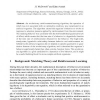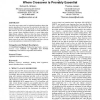291 search results - page 17 / 59 » Building theory in the sciences of the artificial |
GECCO
2005
Springer
14 years 1 months ago
2005
Springer
Mapping biology into computation has both a domain specific aspect – biological theory – and a methodological aspect – model development. Computational modelers have implici...
FUZZIEEE
2007
IEEE
14 years 1 months ago
2007
IEEE
— When multiple sources provide information about the same unknown quantity, their fusion into a synthetic interpretable message is often a tedious problem, especially when sourc...
ECAL
2005
Springer
14 years 1 months ago
2005
Springer
An evolutionary reinforcement-learning algorithm, the operation of which was not associated with an optimality condition, was instantiated in an artificial organism. The algorithm ...
GECCO
2007
Springer
14 years 1 months ago
2007
Springer
One of the most controversial yet enduring hypotheses about what genetic algorithms (GAs) are good for concerns the idea that GAs process building-blocks. More specifically, it ha...
LATA
2009
Springer
14 years 2 months ago
2009
Springer
d abstract) Benjamin Carle, Paliath Narendran and Colin Scheriff Dept. of Computer Science University at Albany–SUNY Albany, NY 12222 June 19, 2007 In this paper we extend the ...


